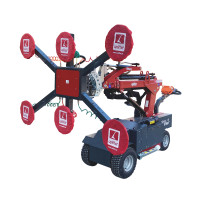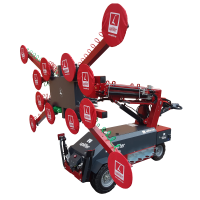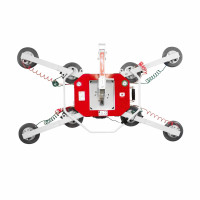Introduction to vacuum lifters for window installation
Installing windows can be a challenging task, especially when it comes to lifting and positioning heavy glass panes. Traditional methods often involve the use of manual labor, which can be time-consuming and prone to errors. However, with the advent of vacuum lifters, window installation has become more efficient and accurate than ever before.
A vacuum lifter is a specialized piece of equipment that uses suction to grip and lift heavy objects, such as glass panels. It operates on the principle of negative pressure, creating a vacuum seal between the lifter and the object being lifted. This innovative technology has revolutionized the window installation industry, providing a safer and more efficient solution.
Benefits of using a vacuum lifter
The use of a vacuum lifter for window installation offers numerous benefits. Firstly, it significantly reduces the risk of accidents and injuries. Traditional methods of lifting glass panels often require multiple people and can be physically demanding. With a vacuum lifter, the task can be accomplished by a single operator, minimizing the risk of strain or accidents.
Secondly, a vacuum lifter enhances efficiency and productivity. The rapid suction and release mechanism allows for quick and precise positioning of glass panels. This eliminates the need for manual adjustments and reduces installation time. As a result, projects can be completed faster, leading to increased customer satisfaction and potentially higher profits.
Moreover, using a vacuum lifter ensures accuracy in window installation. The suction cups provide a secure grip on the glass, preventing any slippage or misalignment during lifting and positioning. This results in perfectly aligned windows, enhancing the overall aesthetics and functionality of the building.
How do vacuum lifters work?
To understand how vacuum lifters work, it is important to grasp the concept of negative pressure. Negative pressure occurs when there is a difference in pressure between two areas, with the lower pressure drawing objects towards it. Vacuum lifters utilize this principle to create a seal between the lifter and the glass panel.
A typical vacuum lifter consists of a frame, a vacuum pump, and a set of suction cups. The frame provides stability and support, while the vacuum pump generates the negative pressure needed for suction. The suction cups, which are attached to the vacuum pump via hoses, come into direct contact with the glass panel.
When the vacuum pump is activated, it removes the air from the space between the suction cups and the glass panel, creating a vacuum seal. This seal allows the lifter to securely grip the glass, enabling it to be lifted and maneuvered into position. Once the glass is in place, the operator can release the vacuum seal, allowing the lifter to disengage from the glass.
Types of vacuum lifters for window installation
There are various types of vacuum lifters available for window installation, each designed to suit different requirements and applications. Understanding the different types can help you choose the most suitable lifter for your specific needs.
- Manual Vacuum Lifters: These lifters are operated manually, requiring the operator to pump a handle to create the suction. Manual vacuum lifters are lightweight and portable, making them ideal for smaller window installation projects.
- Battery-Powered Vacuum Lifters: Battery-powered lifters offer the advantage of mobility and portability without the need for manual pumping. They are often equipped with rechargeable batteries, allowing for extended use on larger projects.
- Air-Powered Vacuum Lifters: Air-powered lifters utilize compressed air to create the necessary suction. They are suitable for heavy-duty applications and can lift larger glass panels with ease.
- Robotic Vacuum Lifters: Robotic lifters are automated systems that can be programmed to lift and position glass panels with precision. They are ideal for high-volume projects and offer unparalleled accuracy and efficiency.
Factors to consider when choosing a vacuum lifter
Choosing the right vacuum lifter for your window installation project requires careful consideration of several factors. These factors will ensure that you select a lifter that meets your specific needs and provides optimal performance.
- Weight Capacity: Determine the weight of the glass panels you will be working with and choose a lifter with a suitable weight capacity. It is essential to select a lifter that can handle the load without compromising safety or efficiency.
- Panel Size: Consider the dimensions of the glass panels you will be installing. Ensure that the lifter's suction cups are large enough to accommodate the size of the panels. Choosing a lifter with adjustable suction cups can provide flexibility in handling different panel sizes.
- Mobility: Evaluate the mobility requirements of your project. If you need to move the lifter between different locations, consider a portable lifter that is easy to maneuver. Battery-powered or air-powered lifters are often more suitable for projects that require mobility.
- Safety Features: Look for lifters that have safety features such as audible alarms or visual indicators that signal when the vacuum seal is compromised. These features can help prevent accidents and ensure the safety of both the operator and the glass panels.
- Maintenance and Service: Consider the maintenance and service requirements of the lifter. Choose a lifter that is easy to clean and maintain, with readily available spare parts and service support. Regular maintenance will ensure the longevity and reliable performance of the lifter.
Safety precautions when using a vacuum lifter
While vacuum lifters are designed to enhance safety during window installation, it is crucial to follow proper safety precautions to prevent accidents or damage to the glass panels.
- Training: Ensure that operators receive proper training on the correct use of the vacuum lifter. They should be familiar with the equipment's operation, safety features, and emergency procedures.
- Inspection: Regularly inspect the lifter and its components for any signs of wear or damage. Pay close attention to the suction cups, hoses, and vacuum pump. Replace any worn or damaged parts immediately.
- Weight Limits: Always adhere to the weight limits specified by the manufacturer. Overloading the lifter can compromise its stability and safety.
- Secure Grip: Before lifting, ensure that the suction cups have a secure grip on the glass panel. Test the grip by gently pulling on the panel to ensure it does not detach.
- Clear Workspace: Clear the work area of any obstacles or debris that could interfere with the lifting process. This will minimize the risk of accidents and ensure a smooth installation.
Tips for maximizing efficiency and accuracy with a vacuum lifter
To maximize efficiency and accuracy when using a vacuum lifter for window installation, consider implementing the following tips:
- Plan and Prepare: Before starting the installation, carefully plan the sequence of windows to be installed and prepare the work area. This will streamline the process and minimize downtime.
- Optimize Positioning: Properly position the suction cups on the glass panel to ensure a secure grip. Positioning the cups closer to the edges of the panel provides better stability during lifting and positioning.
- Use Assistive Tools: Use additional tools, such as guide rails or lifting frames, to assist in aligning and positioning the glass panels accurately. These tools can help reduce the margin for error and ensure precise installation.
- Work in Pairs: If possible, work in pairs when installing larger glass panels. Having an extra set of hands can help with positioning and provide added safety during the installation process.
- Regular Maintenance: Follow the manufacturer's recommended maintenance schedule to keep the lifter in optimal working condition. Regularly clean the suction cups and inspect the lifter for any signs of wear or damage.
Case studies: Successful window installations using vacuum lifters
To illustrate the effectiveness of vacuum lifters in window installation, let's explore a couple of case studies highlighting successful projects.
Case Study 1: Residential Building
A residential building project required the installation of large floor-to-ceiling windows. The construction team opted to use a robotic vacuum lifter for the installation. The robotic lifter's precision and speed allowed for quick and accurate positioning of the windows. The result was a flawless installation that enhanced the building's aesthetic appeal and energy efficiency.
Case Study 2: Commercial Complex
A commercial complex project involved the installation of multiple glass curtain walls. The use of battery-powered vacuum lifters ensured flexibility and mobility throughout the project. The lifters allowed for efficient maneuvering of the glass panels, even in tight spaces. The project was completed ahead of schedule, meeting the client's expectations for quality and timeliness.
Maintenance and care for vacuum lifters
Proper maintenance and care are essential to ensure the longevity and reliable performance of vacuum lifters.
- Regular Cleaning: Clean the suction cups after each use to remove any debris or residue that may affect their gripping ability. Use a mild detergent and warm water, followed by thorough rinsing and drying.
- Inspection: Regularly inspect the lifter for any signs of wear or damage. Check the hoses, seals, and suction cups for any cracks or leaks. Replace any damaged components promptly.
- Lubrication: Apply lubrication to the moving parts of the lifter as recommended by the manufacturer. This will help maintain smooth operation and prevent friction-related issues.
- Storage: Store the lifter in a clean and dry environment, away from direct sunlight or extreme temperatures. Ensure that it is properly secured to prevent any accidental damage.
Conclusion: The future of window installation with vacuum lifters
In conclusion, vacuum lifters have revolutionized window installation, offering increased efficiency, accuracy, and safety. The benefits of using a vacuum lifter, such as reduced risk of accidents, improved productivity, and precise alignment, make it an invaluable tool for the construction industry.
With the availability of various types of vacuum lifters, choosing the right one for your project requires careful consideration of factors such as weight capacity, panel size, mobility, safety features, and maintenance requirements. By following proper safety precautions and implementing tips for maximizing efficiency, you can ensure optimal performance and achieve outstanding results in your window installation projects.
Embrace the future of window installation with vacuum lifters and experience the transformative impact it can have on your construction projects.
Contact us today to explore the range of vacuum lifters available and discover how they can elevate your window installation projects to new heights.














